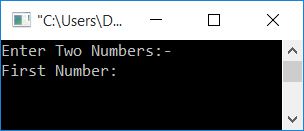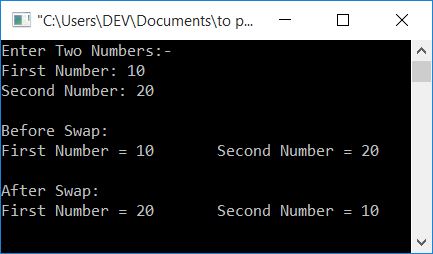- C Programming Examples
- C Programming Examples
- C Print Hello World
- C Get Input from User
- C Print Integer
- C Add Two Numbers
- C Add Subtract Multiply Divide
- C Add n Numbers
- C Area Perimeter of Square
- C Area Perimeter of Rectangle
- C Area Circum of Circle
- C Fahrenheit to Celsius
- C Celsius to Fahrenheit
- C Inches to Centimeters
- C Kilogram to Gram
- C Reverse a Number
- C Swap Two Numbers
- C Interchange Numbers
- C Print ASCII Value
- C Print Fibonacci Series
- C Check Palindrome or Not
- C Check Armstrong or Not
- C Find Armstrong Numbers
- C Find nCr and nPr
- C Find Profit Loss
- C Sum of their Square
- C First & Last Digit Sum
- C Sum of All Digit
- C Product of All Digit
- C Print Total Digit in Number
- C Check Perfect Number
- C Find Basic Gross Salary
- C Round Number to Integer
- C Print Series upto n Term
- C Find Factors of Number
- C if-else & Loop Programs
- C Check Even or Odd
- C Check Prime or Not
- C Check Alphabet or Not
- C Check Vowel or Not
- C Check Leap Year or Not
- C Is Reverse Equal Original
- C Make Calculator
- C Add Digits of Number
- Count Positive Negative Zero
- C Largest of Two Numbers
- C Largest of Three Numbers
- C Smallest of Two Numbers
- C Smallest of Three Numbers
- C Find Factorial of Number
- C Find LCM & HCF
- C Find LCM of n Numbers
- C Find HCF of n Numbers
- C Find Arithmetic Mean
- C Find Average, Percentage
- C Find Student Grade
- C Print Table of Number
- C Print Prime Numbers
- C Find Discount Purchase
- C Calculate Parcel Charge
- C Calculate Wage of Labor
- C Print Phone Bill
- C Conversion programs
- C Decimal to Binary
- C Decimal to Octal
- C Decimal to Hexadecimal
- C Binary to Decimal
- C Binary to Octal
- C Binary to Hexadecimal
- C Octal to Decimal
- C Octal to Binary
- C Octal to Hexadecimal
- C Hexadecimal to Decimal
- C Hexadecimal to Binary
- C Hexadecimal to Octal
- C Pattern Programs
- C Pattern Printing Programs
- C Print Diamond Pattern
- C Print Floyd's Triangle
- C Print Pascal's Triangle
- C Array Programs
- C 1D Array Programs
- C Linear Search
- C Binary Search
- C Largest Element in Array
- C Smallest Element in Array
- C Second Largest/Smallest
- C Count Even Odd
- C Array Element at Even
- C Array Element at Odd
- C Print Even Array Elements
- C Print Odd Array Elements
- C Sum/Product of Even/Odd
- C Reverse an Array
- C Insert Element in Array
- C Delete Element from Array
- C Merge Two Arrays
- C Bubble Sort
- C Selection Sort
- C Insertion Sort
- C Print Common Elements
- C 2D Array Programs
- C Add Two Matrices
- C Subtract Two Matrices
- C Transpose a Matrix
- C Multiply Two Matrices
- C Sum All Matrix Elements
- C Largest Element in Matrix
- C Print Row Column Total
- C 3D Array Programs
- C String Programs
- C Print String
- C Find Length of String
- C Compare Two String
- C Copy a String
- C Concatenate String
- C Reverse a String
- C Count Vowels Consonants
- C Replace Vowel in String
- C Delete Vowels from String
- C Delete Word from String
- C Frequency of Character
- C Count Word in String
- C Remove Spaces from String
- C Sort a String
- C Sort String in Alphabetical
- C Sort Words in Ascending
- C Sort Words in Descending
- C Uppercase to Lowercase
- C Lowercase to Uppercase
- C Swap Two Strings
- C Check Anagram or Not
- C Check Palindrome String
- C Print Number in Words
- C Print Successive Character
- C Character without Space
- C File Programs
- C Read a File
- C Write Content to File
- C Read & Display File
- C Copy a File
- C Merge Two Files
- C Reverse File
- C Count All Character in File
- C List Files in Directory
- C Encrypt & Decrypt a File
- C Delete a File
- C Misc Programs
- Generate Random Numbers
- C Print Date Time
- C Print Message with Time
- C Get IP Address
- C Print Smiling face
- C Pass Array to Function
- Add Two Numbers using Pointer
- C Address of Variable
- C Shutdown Computer
- C Programming Tutorial
- C Tutorial
C Program to Swap Two Numbers
In this article, you will learn how to code the swapping of two numbers in the C language using the following approaches:
- Swap two given numbers using a third variable.
- Swap two given numbers without using a third variable.
- Use a function and a pointer to swap two given numbers.
What is "Swapping of Two Numbers"?
When two numbers are swapped, the first becomes the second and the second becomes the first. For example, if the user enters any two numbers, say 10 and 20. And let's suppose the two variables, say, num1 and num2, hold these two numbers. That is, num1 = 10 and num2 = 20. Then, after swapping, it will be like num1 = 20 and num2 = 10.
Swap two numbers using a third variable in C
The swapping of two numbers in C becomes easy using the third variable. That is, this program uses a variable named "temp" that helps a lot while performing the swap operation of two numbers given by the user at run-time. Let's take a look at the program first.
#include<stdio.h> #include<conio.h> int main() { int num1, num2, temp; printf("Enter Two Numbers:-\n"); printf("First Number: "); scanf("%d", &num1); printf("Second Number: "); scanf("%d", &num2); printf("\nBefore Swap:\n"); printf("First Number = %d\tSecond Number = %d", num1, num2); temp = num1; num1 = num2; num2 = temp; printf("\n\nAfter Swap:\n"); printf("First Number = %d\tSecond Number = %d", num1, num2); getch(); return 0; }
This program was built and runs in the Code::Blocks IDE. Here is its sample run:

Now enter the first number, say 10, and then the second number, say 20. Press the ENTER key to see the following output:

The main block of code for swapping two numbers is:
temp = num1; num1 = num2; num2 = temp;
For example, if the user enters 10 as the first number, then 10 gets initialized to num1. And if the user enters 20 as a second number, then 20 gets initialized to num2. That is, num1 = 10 and num2 = 20.
Now, after executing the statement:
temp = num1;
The value of num1 (that is, 10) gets initialized to temp. Therefore, temp=10. And after executing the statement,
num1 = num2;
The value of num2 (that is, 20) gets initialized to num1. Therefore, num1=20. And again after executing the statement:
num2 = temp;
The value of temp (that is, 10) gets initialized to num2. Therefore, num2=10. As a result, the variable num1 now has the same value as num2. Whereas the variable num2 holds the initial value of num1.
Note: Don't forget to initialize the value of num1 to any third variable before initializing the value of num2 to it.
Swap two numbers without using a third variable in C
Unlike the previous program, this program will not use any type of extra (third) variable in either a direct or indirect way.
#include<stdio.h> #include<conio.h> int main() { int num1, num2; printf("Enter Two Numbers:-\n"); printf("First Number: "); scanf("%d", &num1); printf("Second Number: "); scanf("%d", &num2); printf("\nBefore Swap:\n"); printf("First Number = %d\tSecond Number = %d", num1, num2); num1 = num1+num2; num2 = num1-num2; num1 = num1-num2; printf("\n\nAfter Swap:\n"); printf("First Number = %d\tSecond Number = %d", num1, num2); getch(); return 0; }
This program will produce the same output as the previous one. The following block of code is responsible for swapping two given numbers. Here I've used the addition and subtraction operations:
num1 = num1+num2; num2 = num1-num2; num1 = num1-num2;
For example, let's suppose 10 and 20 are the two numbers entered by the user. Therefore. num1 equals 10 and num2 equals 20. Now, after executing the following statement:
num1 = num1+num2;
The value comes from num1+num2 (that will be 10+20) and gets initialized to num1. Therefore, num1=30. Again, after executing the following statement:
num2 = num1-num2;
The value comes from num1-num2 (that will be 30-20) and gets initialized to num2. Therefore, num2=10. And again, after executing the statement given below:
num1 = num1-num2;
The value comes from num1-num2 (that will be 30-10) and gets initialized to num1. Therefore, num1=20. The value of the first variable is now transferred to the second, and the value of the second variable is transferred to the first.
The Swapping Concept of Using + and -
If there are two numbers. Assume the first number is the total.Then, if you subtract the second number from the total, you'll get the first number. Therefore, it gets initialized to num2 (which now holds the initial value of num1). Again, if you subtract the new value of the second number (the initial value of the first number) from the total, you will get the initial value of the second number. Therefore, it gets initialized to num1 (which now holds the initial value of num2).
Using a Function and a Pointer, swap two numbers in C
This is the last program on the swapping of two numbers. This program uses a user-defined function named swapFun() to swap the two numbers given by the user:
#include<stdio.h> #include<conio.h> void swapFun(int *, int *); int main() { int num1, num2; printf("Enter Two Numbers:-\n"); printf("First Number: "); scanf("%d", &num1); printf("Second Number: "); scanf("%d", &num2); printf("\nBefore Swap:\n"); printf("First Number = %d\tSecond Number = %d", num1, num2); swapFun(&num1, &num2); printf("\n\nAfter Swap:\n"); printf("First Number = %d\tSecond Number = %d", num1, num2); getch(); return 0; } void swapFun(int *num1, int *num2) { int temp; temp = *num1; *num1 = *num2; *num2 = temp; }
This program also produces the same output as the previous two programs.
In the above program, the & is called the address of the operator, whereas the * is called a value at the operator. Therefore, using the address of operator, we've passed the address of both the variables, say, num1 and num2 (that holds the two numbers entered by the user), to the function named swapFun().
And inside the function swapFun(), we have used the value at operator to fetch the value available at the addresses of both variables. The two variables get swapped inside the function. Because we're using the addresses of both variables, the operation that has been done inside the function swapFun() affects the variable's value throughout the program. That is, when we print the value of two variables inside the main() function (after calling the function swapFun()), their value get swapped.
The same program in different languages
« Previous Program Next Program »